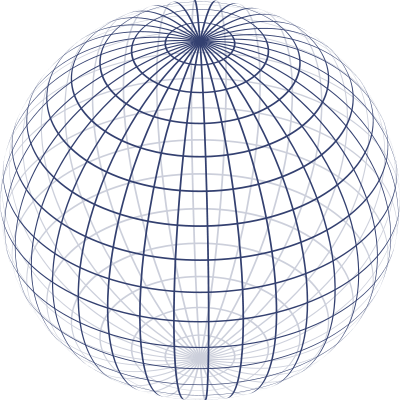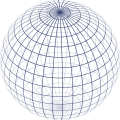This image can be completely generated by the following source code. If you have the gnu compiler collection installed, the programm can be compiled by the following commands:
It creates file Sphere_wireframe.svg in working directory. This file can be viewed using rsvg-view program :
/* sphere - creates a svg vector-graphics file which depicts a wireframe sphere
*
* Copyright (C) 2008 Wikimedia foundation
*
* This program is free software; you can redistribute it and/or modify
* it under the terms of the GNU General Public License as published by
* the Free Software Foundation; either version 2, or (at your option)
* any later version.
*
* This program is distributed in the hope that it will be useful,
* but WITHOUT ANY WARRANTY; without even the implied warranty of
* MERCHANTABILITY or FITNESS FOR A PARTICULAR PURPOSE. See the
* GNU General Public License for more details.
*
* You should have received a copy of the GNU General Public License
* along with this program; if not, you can either send email to this
* program's author (see below) or write to:
* The Free Software Foundation, Inc.
* 51 Franklin Street, Fifth Floor
* Boston, MA 02110-1301 USA
*/
/* The expressions in this code are not proven to be correct.
* Hence this code probably contains lots of bugs. Be aware! */
#include <iostream>
#include <cmath>
#include <cstdlib>
#include <cstring>
using namespace std;
const double PI = 3.1415926535897932;
const double DEG = PI / 180.0;
/********************************* settings **********************************/
int n_lon = 18; // number of latitude fields (18 => 10° each)
int n_lat = 18; // half number of longitude fields (18 => 10° each)
double lon_offset = 2.5 * DEG; // offset of the meridians
double w = 52.5 * DEG; // axial tilt (0° => axis is perpendicular to image plane)
double stripe_grad = 0.5 * DEG; // width of each line
int image_size = 400; // width and height of the image in pixels
double back_opacity = 0.25; // opacity of the sphere's backside
char color[] = "#334070"; // color of lines
int istep = 2; // svg code indentation step
/*****************************************************************************/
double sqr(double x)
{
return(x * x);
}
// commands for svg-code:
void indent(int n, bool in_tag = false)
{
n *= istep;
if (in_tag) n += istep + 1;
for (int i = 0; i < n; i++) cout << " ";
}
void M()
{
cout << "M ";
}
void Z()
{
cout << "Z ";
}
void xy(double x, double y)
{
cout << x << ",";
cout << y << " ";
}
void arc(double a, double b, double x_axis_rot, bool large_arc, bool sweep)
{ // draws an elliptic arc
if (b < 0.5E-6)
{ // flat ellipses are not rendered properly => use line
cout << "L ";
}
else
{
cout << "A ";
cout << a << ","; // semi-major axis
cout << b << " "; // semi-minor axis
cout << x_axis_rot << " ";
cout << large_arc << " ";
cout << sweep << " ";
}
}
void circle(bool clockwise)
{
M();
xy(-1, 0);
arc(1, 1, 0, 0, !clockwise);
xy(1, 0);
arc(1, 1, 0, 0, !clockwise);
xy(-1, 0);
Z();
}
void start_svg_file()
{
cout << "<?xml version=\"1.0\" encoding=\"UTF-8\" standalone=\"no\"?>\n";
cout << "<svg id=\"Sphere_wireframe\"\n";
cout << " version=\"1.1\"\n";
cout << " baseProfile=\"full\"\n";
cout << " xmlns=\"http://www.w3.org/2000/svg\"\n";
cout << " xmlns:xlink=\"http://www.w3.org/1999/xlink\"\n";
cout << " width=\"" << image_size << "\"\n";
cout << " height=\"" << image_size << "\">\n\n";
cout << " <title>Sphere wireframe</title>\n\n";
cout << " <desc>\n";
cout << " about: http://commons.wikimedia.org/wiki/Image:Sphere_wireframe.svg\n";
cout << " rights: GNU Free Documentation license,\n";
cout << " Creative Commons Attribution ShareAlike license\n";
cout << " </desc>\n\n";
cout << " <g id=\"sphere\" transform=\"scale(" << 0.5 * image_size;
cout << ", " << -0.5 * image_size << ") translate(1, -1)\">\n";
}
void end_svg_file()
{
cout << " </g>\n</svg>\n";
}
int main (int argc, char *argv[])
{
// accept -lat and -lon as parameter
for (int i = 2; i < argc; i++)
{
if (isdigit(argv[i][0]) || (sizeof(argv[i]) > sizeof(char)
&& isdigit(argv[i][1])
&& (argv[i][0] == '.' || argv[i][0] == '-')))
{
if (strcmp(argv[i - 1], "-lon") == 0)
{
lon_offset = atof(argv[i]) * DEG;
}
if (strcmp(argv[i - 1], "-lat") == 0)
{
w = atof(argv[i]) * DEG;
}
}
}
double cosw = cos(w), sinw = sin(w);
double d = 0.5 * stripe_grad;
start_svg_file();
int ind = 2; // initial indentation level
indent(ind);
cout << "<g id=\"sphere_back\" transform=\"rotate(180)\" ";
cout << "opacity=\"" << back_opacity << "\">\n";
indent(++ind);
cout << "<g id=\"sphere_half\">\n";
// meridians
indent(++ind); cout << "<g id=\"meridians\"\n";
indent(ind++, true);
cout << "style=\"stroke:none; fill:" << color << "; fill_rule:evenodd\">\n";
double a = abs(cos(d));
for (int i_lon = 0; i_lon < n_lat; i_lon++)
{ // draw one meridian
double longitude = lon_offset + (i_lon * 180.0 / n_lat) * DEG;
double lon[2];
lon[0] = longitude + d;
lon[1] = longitude - d;
indent(ind);
cout << "<path id=\"meridian";
cout << i_lon << "\"\n";
indent(ind, true);
cout << "d=\"";
double axis_rot = atan2(-1.0 / tan(longitude), cosw);
if (sinw < 0)
axis_rot += PI;
double w2 = sin(longitude) * sinw;
double b = abs(w2 * cos(d));
double sinw1 = sin(d) / sqrt(1.0 - sqr(sin(longitude) * sinw));
if (abs(sinw1) >= 1.0)
{ // stripe covers edge of the circle
double w3 = sqrt(1.0 - sqr(w2)) * sin(d);
circle(false);
// ellipse
M();
xy(sin(axis_rot) * w3 - cos(axis_rot) * a,
-cos(axis_rot) * w3 - sin(axis_rot) * a);
arc(a, b, axis_rot / DEG, 0, 0);
xy(sin(axis_rot) * w3 + cos(axis_rot) * a,
-cos(axis_rot) * w3 + sin(axis_rot) * a);
arc(a, b, axis_rot / DEG, 0, 0);
xy(sin(axis_rot) * w3 - cos(axis_rot) * a,
-cos(axis_rot) * w3 - sin(axis_rot) * a);
Z();
}
else
{ // draw a disrupted ellipse bow
double w1 = asin(sinw1);
M();
xy(-cos(axis_rot + w1), -sin(axis_rot + w1));
arc(a, b, axis_rot / DEG, 1, 0);
xy(cos(axis_rot - w1), sin(axis_rot - w1));
arc(1, 1, 0, 0, 1);
xy(cos(axis_rot + w1), sin(axis_rot + w1));
arc(a, b, axis_rot / DEG, 0, 1);
xy(-cos(axis_rot - w1), -sin(axis_rot - w1));
arc(1, 1, 0, 0, 1);
xy(-cos(axis_rot + w1), -sin(axis_rot + w1));
}
Z();
cout << "\" />\n";
}
indent(--ind); cout << "</g>\n";
cout << endl;
// circles of latitude
indent(ind); cout << "<g id=\"circles_of_latitude\"\n";
indent(ind, true);
cout << "style=\"stroke:none; fill:" << color << "; fill_rule:evenodd\">\n";
ind++;
for (int i_lat = 1; i_lat < n_lon; i_lat++)
{ // draw one circle of latitude
double latitude = (i_lat * 180.0 / n_lon - 90.0) * DEG;
double lat[2];
lat[0] = latitude + d;
lat[1] = latitude - d;
double x[2], yd[2], ym[2];
for (int i = 0; i < 2; i++)
{
x[i] = abs(cos(lat[i]));
yd[i] = abs(cosw * cos(lat[i]));
ym[i] = sinw * sin(lat[i]);
}
double h[4]; // height of each point above image plane
h[0] = sin(lat[0] + w);
h[1] = sin(lat[0] - w);
h[2] = sin(lat[1] + w);
h[3] = sin(lat[1] - w);
if (h[0] > 0 || h[1] > 0 || h[2] > 0 || h[3] > 0)
{ // at least any part visible
indent(ind);
cout << "<path id=\"circle_of_latitude";
cout << i_lat << "\"\n";
indent(ind, true);
cout << "d=\"";
for (int i = 0; i < 2; i++)
{
if ((h[2*i] >= 0 && h[2*i+1] >= 0)
&& (h[2*i] > 0 || h[2*i+1] > 0))
{ // complete ellipse
M();
xy(-x[i], ym[i]); // startpoint
for (int z = 1; z > -2; z -= 2)
{
arc(x[i], yd[i], 0, 1, i);
xy(z * x[i], ym[i]);
}
Z();
if (h[2-2*i] * h[3-2*i] < 0)
{ // partly ellipse + partly circle
double yp = sin(lat[1-i]) / sinw;
double xp = sqrt(1.0 - sqr(yp));
if (sinw < 0)
{
xp = -xp;
}
M();
xy(-xp, yp);
arc(x[1-i], yd[1-i], 0,
sin(lat[1-i]) * cosw > 0, cosw >= 0);
xy(xp, yp);
arc(1, 1, 0, 0, cosw >= 0);
xy(-xp, yp);
Z();
}
else if (h[2-2*i] <= 0 && h[3-2*i] <= 0)
{ // stripe covers edge of the circle
circle(cosw < 0);
}
}
}
if ((h[0] * h[1] < 0 && h[2] <= 0 && h[3] <= 0)
|| (h[0] <= 0 && h[1] <= 0 && h[2] * h[3] < 0))
{
// one slice visible
int i = h[0] <= 0 && h[1] <= 0;
double yp = sin(lat[i]) / sinw;
double xp = sqrt(1.0 - yp * yp);
M();
xy(-xp, yp);
arc(x[i], yd[i], 0, sin(lat[i]) * cosw > 0, cosw * sinw >= 0);
xy(xp, yp);
arc(1, 1, 0, 0, cosw * sinw < 0);
xy(-xp, yp);
Z();
}
else if (h[0] * h[1] < 0 && h[2] * h[3] < 0)
{
// disrupted ellipse bow
double xp[2], yp[2];
for (int i = 0; i < 2; i++)
{
yp[i] = sin(lat[i]) / sinw;
xp[i] = sqrt(1.0 - sqr(yp[i]));
if (sinw < 0) xp[i] = -xp[i];
}
M();
xy(-xp[0], yp[0]);
arc(x[0], yd[0], 0, sin(lat[0]) * cosw > 0, cosw >= 0);
xy(xp[0], yp[0]);
arc(1, 1, 0, 0, 0);
xy(xp[1], yp[1]);
arc(x[1], yd[1], 0, sin(lat[1]) * cosw > 0, cosw < 0);
xy(-xp[1], yp[1]);
arc(1, 1, 0, 0, 0);
xy(-xp[0], yp[0]);
Z();
}
cout << "\" />\n";
}
}
for (int i = 0; i < 3; i++)
{
indent(--ind);
cout << "</g>\n";
}
indent(ind--);
cout << "<use id=\"sphere_front\" xlink:href=\"#sphere_half\" />\n";
end_svg_file();
}



